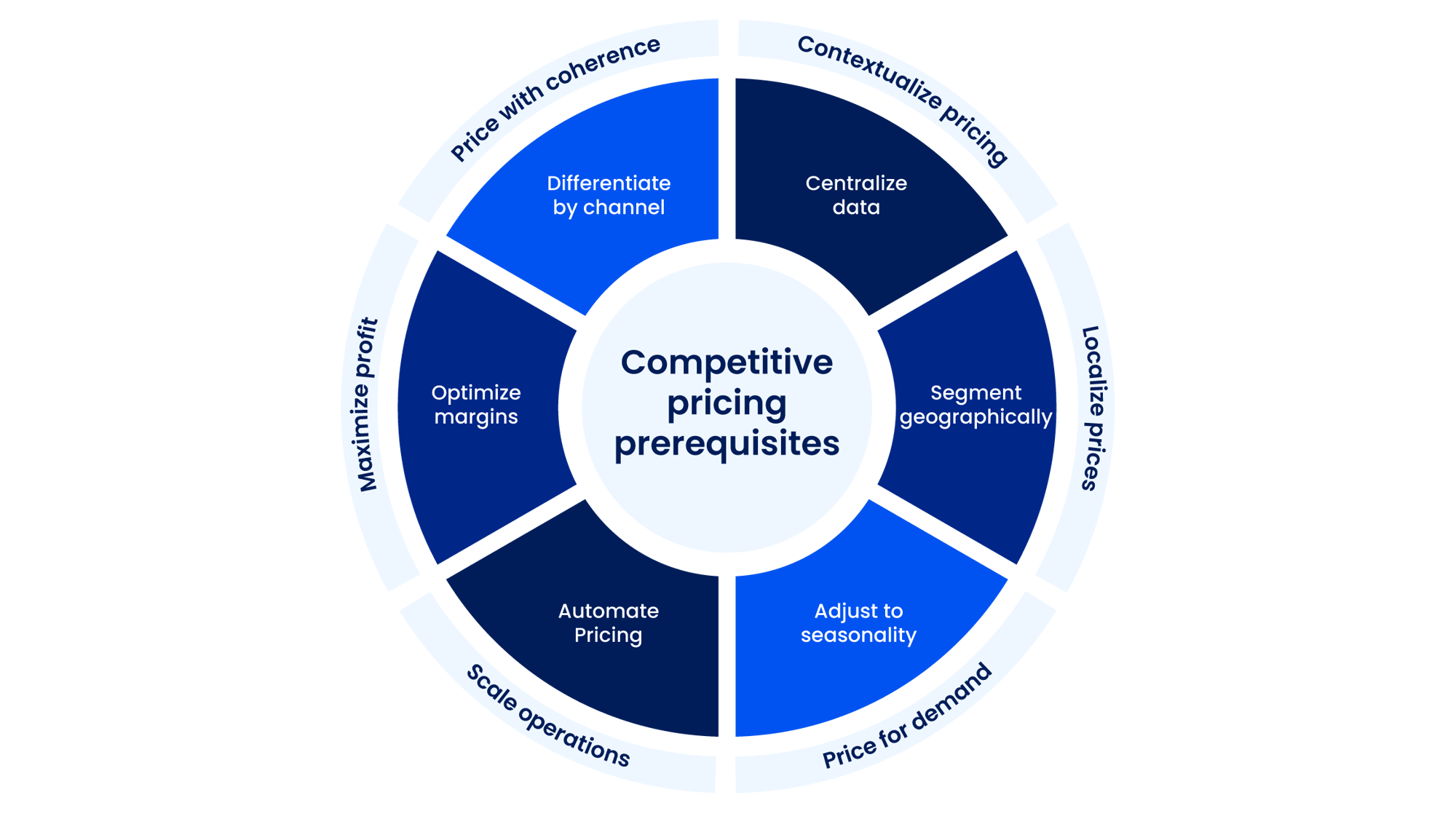BLOG
6 Expert Tips to Unlock the Power of Competitive Pricing

AUTHOR
Anya Policht
DATE OF PUBLICATION
May 2023
TIME TO READ
5 minutes
Pricing has gained increased attention in recent years due to high inflatio, economic uncertainty, and supply chain shortages. This wasn’t always the case. Historically, pricing was considered to be more relevant in certain industries like leisure, tourism, and transport. Today, it’s clear that businesses across all industries must continually optimize their prices to stay ahead of the competition and remain profitable. One of the most effective ways to gain a competitive edge is by leveraging competitive pricing data. It provides valuable insights into your competitors' pricing strategies, enabling you to adjust prices to attract more customers and increase profits. However, simply having access to competitive data is not enough to reap the full benefits of competitive pricing.
Let’s explore 6 prerequisites that you should implement to maximize the value of competitive pricing:
- Centralize data to contextualize pricing decisions
- Localize prices with geographic segmentation
- Adjust prices based on seasonal demand fluctuations
- Differentiate prices by channel to ensure coherence
- Optimize margins to maximize profit
- Implement pricing automation to scale operations

Centralize data to contextualize pricing decisions
Product catalogs can be complex, often containing hundreds of thousands of SKUs. Depending solely on the expertise and abilities of individuals to make pricing decisions is risky. To ensure accuracy and mitigate risk, a data-driven approach is key to making informed pricing decisions. However, data is typically scattered across multiple databases, posing challenges like data cleaning, manual exporting, spreadsheet merging, and endless data matching.
For increased agility and productivity, businesses should develop a centralized and digitized environment, where data is analyzed and pricing decisions are made simultaneously. This approach provides the right foundation to unlock the full potential of competitive data and deliver top-line benefits.
Localize prices with geographic segmentation
Different factors influence consumer behavior and purchase decisions in each geography. Market segmentation must take into consideration local economic conditions, business growth, and competitive challenges. Pricing strategies should reflect these geographical nuances and be flexible to adapt to changing conditions.
Information about competitors and their prices is only relevant in certain locations where those competitors operate. So, if a business wants to use competitor data to make pricing decisions, it needs to consider the specific locations where that data is relevant and adjust prices accordingly. This requires the ability to differentiate prices by geography since the competitive landscape can vary significantly from one location to another. Relying on competitive data alone without taking into account the geographical context can lead to inaccurate pricing decisions.
Adjust prices based on seasonal demand fluctuations
Much like adapting prices based on geography, it’s crucial to adjust prices according to seasonal fluctuations. For example, for an ice cream manufacturer, pricing their ice cream in hot summer weather is different from pricing the same product in freezing winter temperatures. To be effective, the pricing architecture must enable seasonal pricing based on predicted seasonal demand.
When analyzing competitive data, keep in mind that it will be interpreted differently depending on your industry’s seasonality. Before applying competitive pricing, ensure that you can differentiate prices by season.
Differentiate prices by channel to ensure coherence
The proliferation of channels, including webstores, marketplaces, social networks, and quick commerce, has added a layer of complexity for businesses. Each channel presents unique challenges that require pricing adjustments to remain competitive and maintain market share, while also factoring in different costs to protect margins. It's vital to strike a balance to prevent channel cannibalization. For instance, pricing too aggressively on a quick commerce channel may lead customers to switch from the main website or store where margins are higher. Channel coherence is key, and you must ensure that your prices, discounts, and promotions are consistent and dynamically optimized to provide customers with a seamless buying experience.
Depending on the channel, you may face different types of competitors. For example, you might compete with pure players on your website, legacy brands in physical stores, and private labels on marketplaces. Therefore, it's crucial to ensure that your pricing architecture is ready to handle the additional complexity of competitive data when it comes to the various channels.
Optimize margins to maximize profit
By carefully managing margins, businesses can ensure that they are earning a profit while still offering competitive prices to customers. While several factors can influence pricing, such as competition, inventory, and promotions, margin is the core element that must always be considered. To maintain profitability, a company’s pricing approach must be flexible enough to accommodate margin objectives in all pricing decisions.
As you strive to remain competitive, it’s important to be mindful of the potential pitfalls. While competing solely on price may seem like a surefire way to win customers, it can lead to a dangerous price war that ultimately harms all players involved. In such a situation, margins can erode rapidly, and you may end up sacrificing profits unnecessarily. To avoid this scenario, you can set clear boundaries by implementing a minimum margin on top of your competitive pricing rules. This approach provides a hard stop to margin erosion and sends a signal to competitors that price reductions beyond this point are not acceptable. By using competitive pricing in conjunction with a minimum margin strategy, you can strike a balance between competitiveness and profitability.
Implement pricing automation to scale operations
To optimize pricing for extensive product catalogs, businesses need a scalable approach that factors in geography, seasons, and channels, in addition to margin objectives and relevant pricing data. This is where pricing automation comes in as a crucial tool to scale operations and eliminate time-consuming, error-prone manual tasks associated with spreadsheet pricing. By starting with scalable business rules, businesses can automate pricing for their entire catalog across all contexts, enabling them to maintain control of their pricing strategies while freeing up pricing resources to focus on high-value tasks.
Adding competitive data to the mix inevitably means more complexity in your pricing decisions. Automating pricing processes ensures that competitive data is correctly leveraged. Once an automation tool has been successfully implemented, you can then further enhance your pricing intelligence through the use of AI/ML.
Ready to leverage competitive pricing?
To thrive in today's fiercely competitive commerce landscape, businesses must adopt a strategic approach to pricing that ensures profitability while maintaining a competitive edge. Competitive pricing is a crucial factor enabling businesses to remain relevant and attractive to customers. Centralizing data, localizing prices with geographic segmentation, adjusting prices based on seasonal demand fluctuations, differentiating prices by channel to ensure coherence, optimizing margins to maximize profit, and implementing pricing automation are all key elements that businesses must consider to unlock the full potential of competitive pricing data.
At Pricemoov, we specialize in helping businesses strike the right balance between competitiveness and profitability. We can help you implement all of these key elements and more to empower you to fully leverage competitive pricing. Contact us today to discuss how we can help you stay ahead of the competition.




